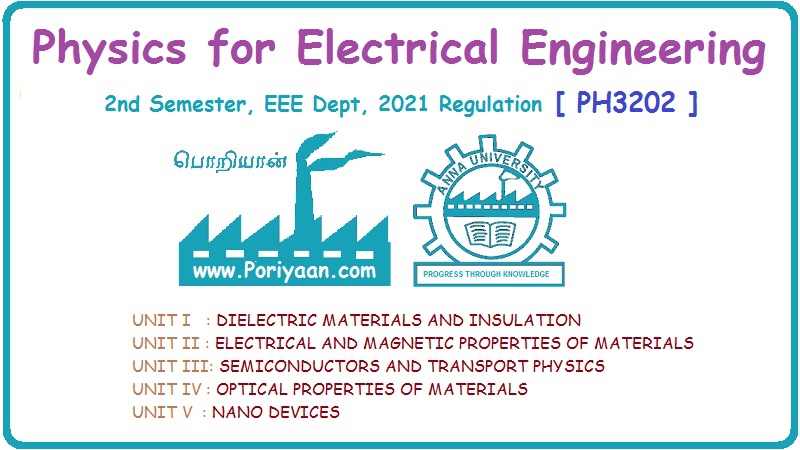Physics for Electrical Engineering: Unit IV: Optical Properties of Materials
Modulators
Different electro optic modulators
These are used to modulate the intensity or phase of light by an electric field. The different electro optic modulators are (a) Electrooptic modulators based on Kerr effect (b) Electrooptic modulators based on Pockels effect. (c) Electro absorption modulator by Franz Keldysh and stark effect. (d) Quantum well electro absorption modulator.
MODULATORS
These
are used to modulate the intensity or phase of light by an electric field. The
different electro optic modulators are
(a)
Electrooptic modulators based on Kerr effect.
(b)
Electrooptic modulators based on Pockels effect.
(c)
Electro absorption modulator by Franz Keldysh and stark effect.
(d)
Quantum well electro absorption modulator.
KERR EFFECT
Optical
anisotropy induced in an isotropic liquid under the influence of an electric
field is known as the Kerr effect. (John Kerr discovered
it in 1875).
A
Kerr cell is required for studying the effect. It consists of a sealed sealed
glass cell filled with a liquid comprising of asymmetric molecules. Two plane
electrodes of length L are arranged parallel to each other.
When
a voltage is applied to the electrodes a uniform electric field is produced in
the cell. The Kerr cell is placed between a crossed polarizer system. The
molecules of the liquid tend to align along the electric field direction. (Fig.
4.30)
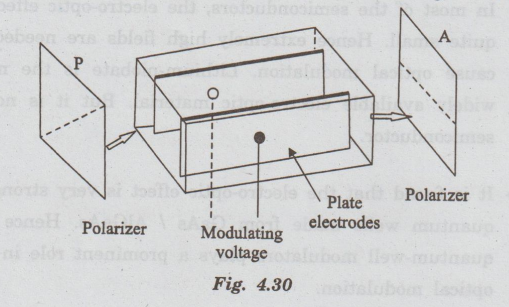
As
the molecules are asymmetric, the alignment causes anisotropy and the liquid
becomes double refracting.
The
induced birefringence is proportional to the square of the applied electric
field (E) and to the wavelength of incident light (λ). Thus
Δμ
∝ λ
Δμ
∝ E2
Δμ
= K λ E2
where
K is known as the Kerr constant.
The
vibration direction of plane polarized light passing between crossed polarizer
is rotated.
Among
the liquids, nitrobenzene (C6H5NO2) is found
to have the highest value for the Kerr constant. therefore, Kerr cells use
nitrobenzene.
Kerr
cell is used as (i) an electro-optic shutter in high-speed photography. (ii) a
light chopper in the measurement of the speed of light.
Pockels Effect
F.
Pockels discovered in 1893 that the application of an electric field to
piezoelectric crystals makes them birefringent.
Normally, piezoelectric crystals are birefringent but in certain directions do
not exhibit double refraction.
When
an electric field is applied along these directions, double refraction is
induced along these directions also.
A
Pockels cell consists of a piezoelectric crystal, for example lithium niobate
placed between crossed polarisers.
Transparent
electrodes (thin conducting coatings of tin oxide or indium) are deposited on
opposite sides of the crystal.
The
crystal is oriented with its optic axis along the direction of the electric
field. The transparent electrodes ensure free propagation of light through the
crystal. A Pockels set up is shown in fig.4.31.
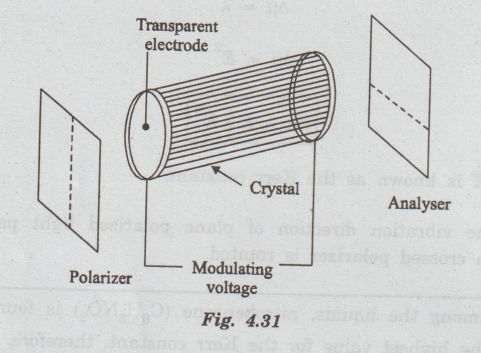
The
birefringence induced in the crystal is proportional to the strength of the
applied field.
Thus,
Δμ
∞ E
Δμ
= kE
where
k is a constant depends on characteristic of the material. Equ. shows that
Pockels effect is a linear effect.
The
total birefringence of the cell is initially made equal to 2/2. When the
electric field is increased, the beam is transmitted or hindered depending on
the phase difference between the o-ray and e-ray.
The
device switches on and off periodically. Pockels cells are used in fast
switching applications and in fibre optics. It can be used to obtain amplitude,
frequency or phase modulation.
The
piezoelectric crystals of ammonium dihydrophosphate (ADP) and potassium
dihydrophosphate (KDP) are widely used in Pockels cell.
Kerr
and Pockels cells are widely used as electro-optic shutters in Q-switching of
lasers.
Franz - Keldysh and Stark Effect Electroabsorption Modulators
Generally,
semiconductors absorb the photon when the photon energy is equal to or greater
than the bandgap energy (Eg) of the semiconductor.
In
some cases the doped impurities in the semiconductor may also absorb the
photons. For this absorption, the energy of the photon must be at least equal
to the ionization energy of the impurity atom.
This
low energy donor band and acceptor band absorption transitions have been
observed in many semiconductors.
(i)
Franz - Keldysh effect:
The
absorption of light photons having energies less than the band gap energy of
the semiconductor by applying a strong electric field is called as Franz
Keldysh effect.
Fig.
4.32 shows the bending of energy bands due to the presence of electric field.
When there is no photon and the electric field, the wave functions of electron
at A (valance bond) and B (conduction band) are decaying without overlapping in
the bandgap.
The
increase of electric field (E), decreases the distance AB and hence the
overlapping of wave functions within the energy gap increases.
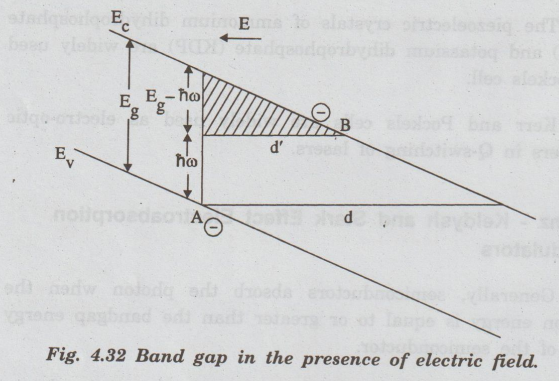
When
there is no photon, the valence electron has to tunnel through a triangular
barrier of height 'Eg' and thickness d = Eg|qE.
By
absorption of photon having energy hv < Eg the thickness is
reduced to
Eg
– hv / qE Therefore the overlapping of the qE wavefunctions further
increases and the electron from valence band can easily tunnel to the
conduction band. Thus, an absorption of photon having energy h v < Eg
in the presence of strong electric field produces electron tunneling.
Thus
the Franz-Keldysh effect is a photon assisted tunneling of electron through the
barrier. The absorption of photon by the electron depends on the strength of
applied field.
Generally,
the Franz - Keldysh effect occurs when the applied electric field E is more
than 107 V m-1.
(ii) Stark effect:
The
Energy level splitting of the outer 2s or 2p states and hence absorption of
photon whose energy is less than the band gap by an applied electric field is
called Linear stark effect.
Energy
level splitting of ground level (1s) states and hence absorption of photon
whose energy is less than the bandgap by an applied electric field is known as
quadratic or second order stark effect.
Thus
the Franz - Keldysh effect and Stark effect refer to the electron tunneling via
electro-absorption.
Using
these effects the modulation of light can be done by applying sequence of
electric pusles. These type of modulators are called electroabsortion
modulators.
Consider
the light photon energy smaller than the bandgap energy of semiconductor. When
there is no applied field (Fig.4.33), the light photon is completely
transmitted without any absorption.
When
the bias pulses are applied which correspond to the signal to be transmitted,
there is attenuation of transmitted light depending upon the value of magnitude
of applied bias pulses.
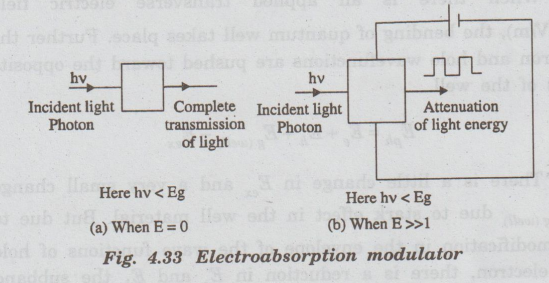
Drawbacks
1.
The electroabsorption effects are very weak.
2.
To increase the clectro absorption effect, very large electric fields (107
V/m) or very long devices (~ several millimetres) are needed.
Hence
these electroabsorption effects are not used to modulate the light since the
applied field signal is not very large.
Quantum well electroabsorption modulators
The
electron in a potential well of infinite depth cannot escape through the walls
of the potential well. Thus, the electron is confined in the region defined by
the well width. Further its energies are quantised.
Figure
4.34 shows the ground sate wavefunctions of the electron and hole sub band with
zero field. Taking Eph = absorbed photon energy, Ee and Eh
are the electron an hole subband energies, Eex binding energy of
exciton and Eg (well) = bandgap energy between conduction band and
valence band. The transition energy is given by finite transverse electric
field (fig. 4.34(b)).
When
there is an applied transverse electric field (10 V/m), the bending of quantum
well takes place. Further the electron and hole wavefunctions are pushed toward
the opposite sides of the well.
Eph
=Ee + Eh + Eg(well) – Eex
There
is a little change in E and a very small change in E due to stark effect in the
well material. But due to g (well) the modification in the envelope of the wave
functions of hole and electron, there is a reduction in Ee and Eh
the subband energies.
A
quantum well is a potential well with thick walls (≈100Å). The electrons and
holes (particles) are confined in the region defined by the well width.
Similarly there is also multiple quantum well formed by two or more lattice
matched materials.
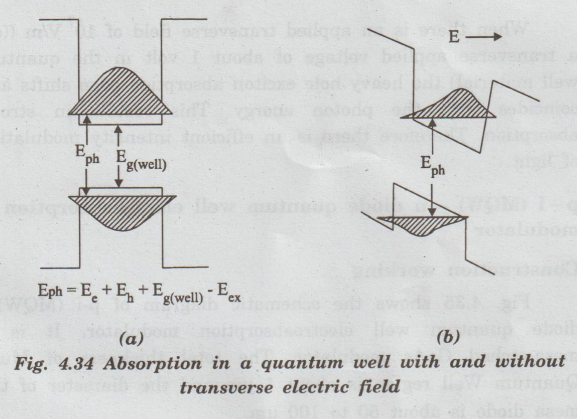
So
the ground state inter-subband energy separation is very small. This results in
a shift of the absorption spectrum to lower energies. This shift is the
dominant effect which results a pronounced red shift of the absorption edge.
This shift is called Quantum Confined Stark Effect (QCSE). This shift is larger
than the stark shift (or) Franz - Keldysh effect in bulk semiconductors.
This
enormous shift is due to small size (100 Å) of quantum well. The shift is
proportional to square of the electric field and to fourth power of the quantum
well width. This effect is utilised to design efficient electroabsorption
light modulators.
When
the energy of the incident photon is (20 meV) below the heavy hole exciton
absorption (50 meV) at zero applied electric field, there is no absorption of
the incident light. So the input light is completely transmitted through the
quantum well material.
When
there is an applied transverse field of 10' V/m ((or) a transverse applied
voltage of about 1 volt in the quantum well material) the heavy hole exciton absorption
edge shifts and coincides with the photon energy. This results in strong
absorption. Therefore there is an efficient intensity modulation of light.
p-i
(MQW) - n diode quantum well electroabsorption modulator
Construction
working
Fig. 4.35 shows the schematic diagram of p-i (MQW)-n diode quantum well electroabsorption modulator. It is a mesa-etched GaAs modulator. The total thickness of Multi Quantum Well region is about 1 μm and the diameter of the mesa diode is about 50 to 100 μm.
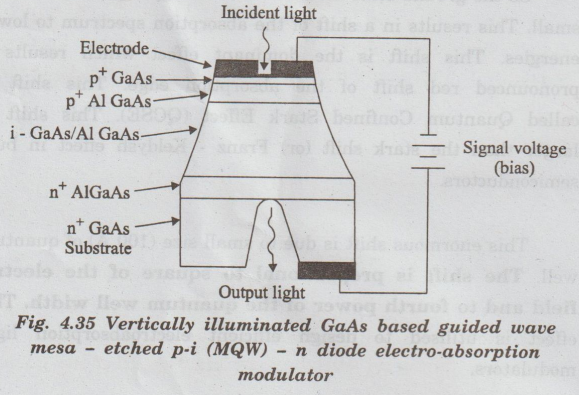
•
The optical window (i.e. entrance gate
for incident light) is situated at the top of the p-i-n diode is about half of
the diode area. The p-i-n diode is made by photo lithography, selective etching
and ohmic contact formation.
•
Since the GaAs substrate is not
transparent to light, it is selectively etched under the active region of the
diode. The light is transmitted through the diode or normal to the plane of the
quantum well layers.
•
It is available in the form of integrated and waveguide form. Due to the
waveguide structure and optical confinement, there is a single mode
transmission.
•
Since the p-i-n diode is reverse biased, when there is no applied transverse
electricfield, there is no flow of art current in the external circuit. When
there is an applied transverse fie (or bias signal), the incident light photon
is absorbed and corresponding there is an increased current flow in the
external circuit.
Thus
the modulation of light takes place which is proportional to the applied
transverse electric field or bias signal strength. The modulation band width of
40 GHz can be obtained because of very small time constant of the device.
Physics for Electrical Engineering: Unit IV: Optical Properties of Materials : Tag: : Different electro optic modulators - Modulators
Related Topics
Related Subjects
Physics for Electrical Engineering
PH3202 2nd Semester 2021 Regulation | 2nd Semester EEE Dept 2021 Regulation
